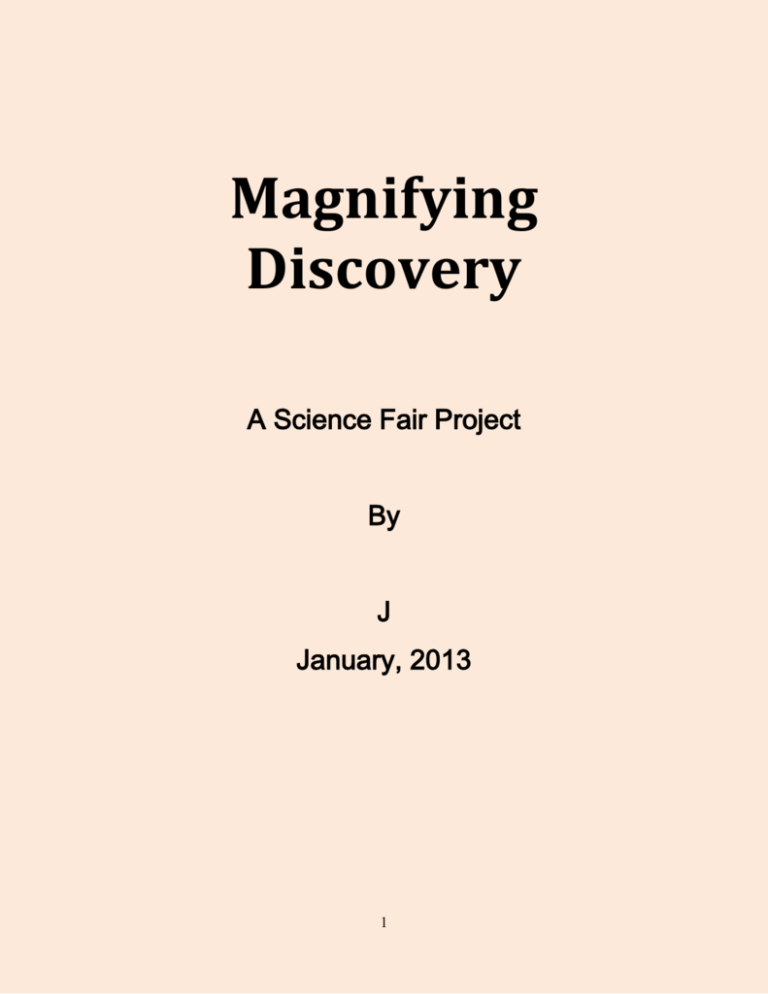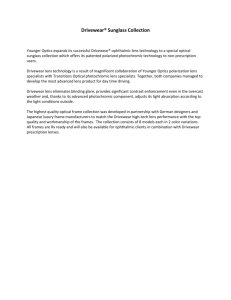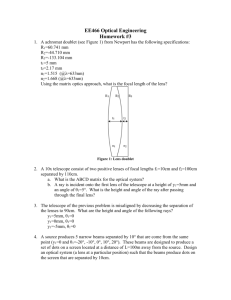Magnifying Discovery
advertisement

Magnifying Discovery A Science Fair Project By J January, 2013 1 Abstract 2 Table of Contents Title Page…………………………………………………………………1 Abstract……………………………………………………………………2 Introduction……………………………………………………………….4 Problem ……………………………………………………………4 Hypothesis …………………………………………………………4 Independent Variable ………………..……………………………4 Dependent Variable …………………………………….…………4 Constants or Controlled Variables…………………………..……4 Background Research………………..……………………………4 List of Materials…………………………………………………………….5 Experimental Procedure...………………………………………………..6 Data Tables………………………………………..……………………….8 Data Analysis and Discussion………………………………………..….8 Graph ……………………………………………………………………..10 Conclusion………………………………………………………………..11 Bibliography………………………………………………......................12 3 A Magnifying Discovery Introduction Problem: How does distance of an object from a lens affect its magnification? Purpose: In this experiment I will measure the apparent size of an object through a magnifying lens at different optical distances compared to the actual size of the object and discover a relationship between magnification and optical distance of a lens.. Hypothesis: If the distance between an object being viewed and the hand lens is increased, then the size of an object as seen through the lens will increase. Independent Variable.: Distance between the object and the lens. Dependent Variable: The optical or apparent size of the object, or the size of the object as seen from the lens. Constants or Controlled Variables: Same lens, same ruler for measuring distance, same set up for the experiment, same observer taking measurement, same hand lens, measurement tape, and set up for the ruler. 4 List of Materials Hand lens or magnifying glass Ruler Permanent marker Scotch tape Wax paper Drinking straw String or twisty tie Modeling clay Small objects to measure (dime, eraser, black eye pea and red kidney bean) Research Background Optics is the study of light and how light travels through different objects in different ways. If one looks at an object through a glass of water, the object looks smaller through the glass than when looking at it through the air. This occurs because light travels differently through the glass and water, causing the image to bend. Your eyes see this as a smaller object, even though your brain knows that the object is still the same size. Light traveling through water is bent because water is denser than air. This is called refraction. Glass materials also bend light and so they are used in making lenses. 5 A lens works when light goes through it and refracts (bends) inside the lens, so the light basically refracts inside the lens. Optics is scientific study of light. Magnification is used to make objects larger. Have you ever looked through a magnifying lens? Why do things look bigger when you look at them through the magnifying lens? Even though the object appears to get larger, it really stays the same size. Each lens has its own unique power of magnification, which can be measured with a ruler. Terms and Concepts: Magnification - The act of making something look bigger than its actual size. Optics - The branch of physical science that deals with the properties and phenomena of both visible and invisible light and with vision. Lens - A piece of transparent substance, usually glass, having two opposite surfaces either both curved or one curved and one plane, used in an optical device in changing the convergence of light rays, as for magnification, or in correcting defects of vision. Optical distance - Physical distance multiplied by the index of refraction of the medium. Actual measurement - Direct measurement of distance between the object and the lens Optical measurement - a measurement technique that relies on the use of optical sensors to collect measurement. 6 Experimental Procedure 1. Cut out a piece of scotch tape and place it on a piece of wax paper. 2. Mark points along the tape in millimeters using a ruler. 3. Fold the drinking straw around the ruler and twist it around the ruler. 4. Use a twist tie to tie the handle of the hand lens to the straw. Make sure the side of the hand lens with the marked tape is facing up. 5. Use the modeling clay to mount the ruler on the desk. 6. Using a ruler measure the length of the object. If it is a spherical object, measure the diameter or the longest side and record it in the data table. 7. Place the object to be viewed on the desk under the lens and measure the length of the object as seen through the lens. This is the optical size. Record optical size and the distance from the lens on the data table. 7 8. Repeat step 8 all the objects. 9. For the Red Kidney Beans observe and measure the optical size at different distances from the lens. 10. Record the data and plot a graph of optical distance on the x-axis and optical size on the y-axis. Data Table Object Actual Size Distance from Optical Size Increase in (cm) Lens (cm) (cm) Size (cm) Eraser 2.5 cm 7 cm 9 cm 7.5 Dime 1.6 cm 2.5 cm 11 cm 9.4 0.7 cm 2 cm 1.2 cm 0.5 1.5 cm 4 cm 2.5 cm 1 (coin) Black Eye Pea Red Kidney Bean 8 Optical Sizes of Red Kidney Beans at Different Distances from the Lens IV: Distance Between Red Kidney DV: Optical Size of Kidney Red Beans and Lens (cm) Beans (cm) 4 2.5 5 2.7 6 2.9 7 3.0 8 3.2 9 3.5 9 Optical Size vs. Distance of Lens from Objects 4 3.5 Optical Size 3 2.5 2 Optical Size vs. Distanc e of Lens from Objects 1.5 1 0.5 0 0 2 4 6 8 10 Distance of Lens from Objects Data Analysis and Discussion All the objects tested increased in size when viewed from the lens. The sizes f the eraser increased from 2cm to 9 cm when it was 7 cm away from the lens. The dime at 2cm from the lens its size increased from 1.6 cm to 11 cm. The sizes of Black Eye Pea and Red Kidney Beans increased from 0.7 and 1.5 cm to 1.2 cm and 2.5 cm respectively. Looking at the Red Kidney Bean from the distances of 4 cm, 5 cm, 6 cm, 7 cm, 8 cm, and 9 cm, the optical sizes were 2.5 cm, 2.7 cm, 2.9 cm, 3.0 cm, 3.2 cm and 3.5 cm respectively. 10 Conclusion: The actual size of the Red Kidney Bean is 1.5 cm. At distances of 4 cm, 5 cm, 6 cm, 7 cm, 8 cm, and 9 cm from the lens, the optical sizes were 2.5 cm, 2.7 cm, 2.9 cm, 3.0 cm, 3.2 cm and 3.5 cm respectively. Therefore the results support the hypothesis which stated that if the distance between an object being viewed and the hand lens is increased, then the size of the object as seen through the lens will increase. Bibliography http://www.sciencebuddies.org/science-fairprojects/project_ideas/Phys_p021.shtml 11








